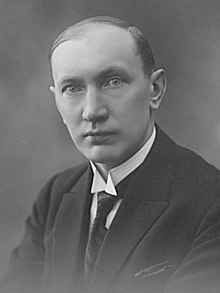Paul Kogerman
Paul Kogerman (born November 23 . Jul / 5. December 1891 greg. In Tallinn ; † 27. July 1951 ) was an Estonian chemist . He is particularly known for his work on oil shale .
life and work
Paul Nikolai Kogerman was born into a seafaring family. He passed his Abitur as an external student in Tallinn in 1913. Kogerman graduated from Tartu University in 1918 . From 1919 to 1922 he completed an Estonian state scholarship at Imperial College London . From 1921 to 1936 he worked at the University of Tartu, from 1925 on with the rank of professor. In 1926 and 1933 he was a visiting professor at the Swiss Federal Institute of Technology in Zurich and in 1927/28 at Harvard University . In 1934 he received his doctorate in chemistry in Zurich. In 1938 Kogerman was accepted into the newly established Estonian Academy of Sciences .
In 1925, together with the Estonian chemist Michael Wittlich (1866–1933) , Kogermann founded a laboratory for researching oil shale , which gained international renown. In 1941 he became director of the laboratory. From 1936 to 1941 Kogerman worked at the Tallinn University of Technology (TTÜ) and from 1936 to 1939 its rector. From October 1939 until the Soviet occupation of Estonia on June 21, 1940, Kogerman was Minister of Education of the Republic of Estonia .
The Soviet occupation authorities deported Kogerman and his family in 1941. Until 1945 he was a prisoner in a prison camp in the Sverdlovsk Oblast in interior Russia . He was then allowed to return to the Estonian SSR .
In 1946 Kogerman was admitted to the Academy of Sciences of the Estonian Soviet Socialist Republic. From 1945 to 1951 he was head of the chair of organic chemistry and pyrogenetic processes at the Tallinn Polytechnic. From 1947 to 1950 he held the rank of director of the Institute for Chemistry of the Academy of Sciences.
Oil shale
Paul Kogerman is known internationally for his work on oil shale. He presented fundamental work on the structure and origin of oil shale, its chemical properties and the thermal decay processes. As Estonia's only indigenous source of energy, oil shale played a particularly strategic role for the pre-war Republic of Estonia and later for energy generation within the Soviet Union.
literature
- Helle Martinson, Karl Martinson: Akadeemik Paul Kogerman. Põlevkivikeemia rajaja Eestis. Tallinn 1981
- Aili Kogerman: Paul Kogerman yes tema aeg. Tallinn 2004 ( ISBN 9985-50-366-X )
Web links
- Literature by and about Paul Kogerman in the catalog of the German National Library
- Curriculum vitae ( memento of February 19, 2012 in the Internet Archive ) (Tallinn University of Technology)
Individual evidence
- ↑ Entry in the baptismal register of St. John's Church in Reval (Estonian: Tallinna Jaani kirik)
- ↑ Eesti Elulood. Tallinn: Eesti Entsüklopeediakirjastus 2000 (= Eesti Entsüklopeedia 14) ISBN 9985-70-064-3 , p. 171
| personal data | |
|---|---|
| SURNAME | Kogerman, Paul |
| BRIEF DESCRIPTION | Estonian chemist |
| DATE OF BIRTH | December 5, 1891 |
| PLACE OF BIRTH | Tallinn |
| DATE OF DEATH | July 27, 1951 |
| Place of death | Tallinn |
